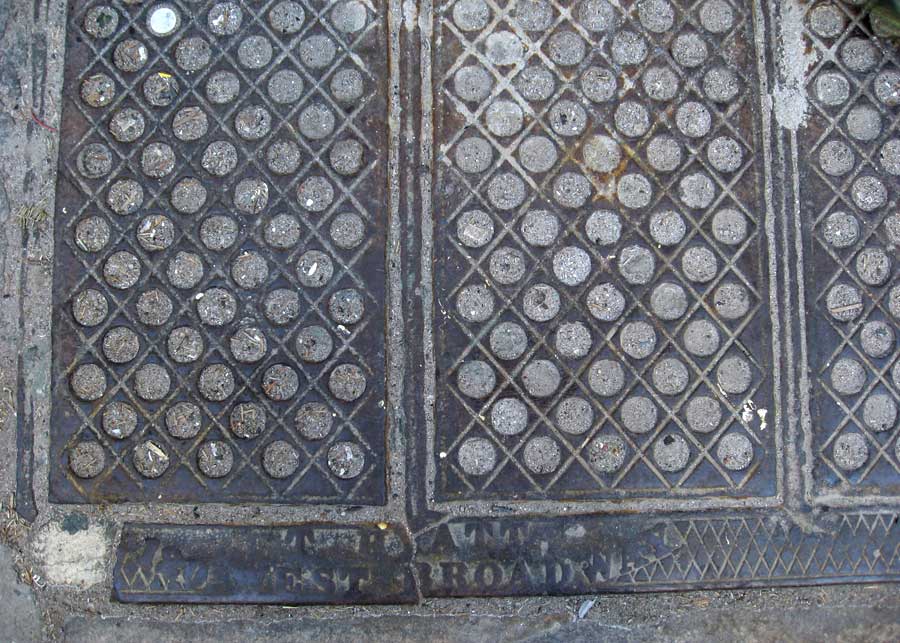

 T Hyatt 120 West Broadway (Howard St. between Broadway & Mercer St.) (2009)
T Hyatt 120 West Broadway (Howard St. between Broadway & Mercer St.) (2009)

The manufacturer of these vault lights is identified as "T Hyatt 120 West Broadway." They are located on Howard St., New York City, at the rear of a building which has the address 309-311 Canal St. (northeast corner of Mercer St.) on its front side.
Thaddeus Hyatt (1816-1901) was an inventor, who claimed to have invented the vault light system used throughout New York City to provide light to basement spaces under sidewalks from the late 1840s until the era of electric lights. He filed patents to substantiate his claim, the first in 1845 for "thick glass discs set within iron grilles ... letting natural light into the basement and avoiding the need for gas lighting and its attendant fumes" (quoted from Historic Prism Glass Companies of the United States). An extensive gallery of New York vault lights is found on the Glassian.org website.
Hyatt's patent no. 4,266, dated 12 Nov. 1845, claimed, "I have so contrived my illuminating vault-cover, as to admit the light through a considerable number of small glasses, or lenses, which are so set into the iron cover, as effectually to defend them from injury by the falling or pressure of weighty bodies upon them, or from the expansion and contraction of the metal, they being protected by knobs, or protuberances on the iron cover, and defended also by being set in a frame work of wood or of soft metal, or of wood and soft metal combined, which will yield to percussion and thus aid effectively in preventing the breaking of the glass." At a later date Hyatt's patent no. 21,050, dated 27 July 1858, claimed to improve illuminating vault covers by employing "glasses of the form of an inverted pyramid, or some other analogous polygonal or conical form which by reflection and refraction will laterally diffuse the descending rays of light uniformly throughout the apartment which is lighted thereby." Much earlier Hyatt, with Norman T. Winans and (his brother) Theodore Hyatt, patented improvements "in the composition of matter for the manufacture of friction-matches" (Patent Nos. 2,402 and 2,403, dated 23 December 1841).
The 1860 U. S. Census (non-population schedules for manufacturers) recorded Thaddeus Hyatt, Patent Vault Lights. He owned real capital worth $1000 and raw materials worth $4900. These consisted of 20,000 pounds of glass ($2400) and other articles ($2500). He employed an average number of 30 hands, and paid $900 average monthly wages. The previous year's production amounted to 7000 feet of vault lights valued at $40,000.
Apart from his business life, Thaddeus Hyatt has another claim to fame. He was a friend of the abolitionist, John Brown, and after Brown's execution for treason Hyatt was summoned to appear before Congress to testify regarding his involvement in the insurrection. Hyatt refused to appear and was imprisoned for his refusal. This was the first time anybody had challenged the government's power in this area. Ultimately his case led to a Supreme Court decision affirming Congress's right to summon witnesses.
Thaddeus Hyatt was born in Rahway, New Jersey, and died on the Isle of Wight. His obituary in the New York Times, 27 July 1901, p. 7, reads in part, "Thaddeus Hyatt, an inventor, and who at the time of the anti-slavery agitation in this country was an ardent abolitionist and close friend of John Brown, died Thursday at Sandown, Isle of Wight, England... Mr. Hyatt invented the bullseye glass lens, used as a means of increasing the light in vaults under street sidewalks, and his invention made him wealthy.
"In the fifties, when the anti-slavery agitation began to assume definite form, Mr. Hyatt associated himself with the leaders in the movement and gave his means for the advancement of the doctrine of universal freedom. He became a close friend of John Brown, who whenever he came to New York made his headquarters at Mr. Hyatt's Morton Street house. After the execution of John Brown Mr. Hyatt was summoned to appear before the United States Senate to give evidence regarding the movements leading up to the Harper's Ferry demonstration. He refused and was committed to the Old Capitol Prison in Washington. Instead of taking his imprisonment seriously he had his prison room decorated and furnished and then issued invitations to his friends. He never lacked visitors.
"From the prison Mr. Hyatt wrote home to the newspapers and kept up a fearless agitation of the question. Those who were opposed to him saw the error of their course, and on motion of the Senator who had caused his imprisonment he was ordered to leave the prison. He promptly telegraphed to New York: 'Have been kicked out. Will be home to-morrow.'"
There is more T. Hyatt cast iron at 44 Walker St. (click for image). These run along the base of a front window. At one time there may have been vault lights here.
The date of Hyatt's original patent (Nov. 12, 1845) is referred to here on Duane St. These vault lights were probably manufactured by Jacob Mark.
Hyatt's patent is also referred to here on these vault lights at 50 White St. These were probably manufactured by J. B. & W. W. Cornell, whose mark is found nearby (click for image).
The Hyatt vault lights in front of 48 and 52 Morton St. are somewhat unusual. They are on a wide sidewalk in front of residential buildings. Is there accessible space beneath that needed lighting in the days before electricity? (Click for image.) These read simply T HYATT 120 WEST BROADWAY.
Copyright © 2009 Walter Grutchfield